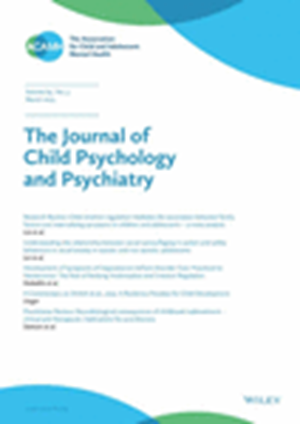Motor stereotypies in toddlers with and without autism: A transdiagnostic dimension.
IF 7
1区 医学
Q1 PSYCHIATRY
引用次数: 0
Abstract
BACKGROUND Motor stereotypies (MS) represent one of the transdiagnostic symptom dimensions identified by the NIMH Research Domain Criteria work group as relevant to psychopathology. MS are common in neurodevelopmental conditions, but they remain poorly understood, particularly in early childhood. The present study examined MS in 648 toddlers with autism spectrum disorder (autism, n = 455) and other neurodevelopmental conditions (non-autism, n = 193) and their concurrent and prospective links with other phenotypic characteristics. METHODS Toddlers were recruited between February 2000 and October 2018 and evaluated at 24 +/- 5 months (Time 1, N = 648) and 41 +/- 6 months (Time 2, N = 455). The presence of MS was determined based on the Autism Diagnostic Observation Schedule assessment. The phenotypic measures included adaptive socialization skills, severity of social symptoms of autism, and verbal, nonverbal, and motor skills. The analysis was conducted using the general linear models while controlling for age, sex, visit year, group, and other relevant covariates. RESULTS MS were present in both groups, but were more common and intense in autism, and their prevalence did not vary by sex in either group. Regardless of group, MS was associated concurrently with higher social-affective symptoms [p < .001, η p 2 $$ {\eta}_{\mathrm{p}}^2 $$ = .034], lower socialization [p = .001, η p 2 $$ {\eta}_{\mathrm{p}}^2 $$ = .017], expressive language [p = .008, η p 2 $$ {\eta}_{\mathrm{p}}^2 $$ = .011], visual reception [p = .002, η p 2 $$ {\eta}_{\mathrm{p}}^2 $$ = .015], fine motor [p < .001, η p 2 $$ {\eta}_{\mathrm{p}}^2 $$ = .020] and gross motor [p < .001, η p 2 $$ {\eta}_{\mathrm{p}}^2 $$ = .032] scores, and prospectively with higher social-affective symptoms [p = .011, η p 2 $$ {\eta}_{\mathrm{p}}^2 $$ = .014], lower socialization [p = .039, η p 2 $$ {\eta}_{\mathrm{p}}^2 $$ = .009], and lower verbal scores [p < .014, η p 2 $$ {\eta}_{\mathrm{p}}^2 $$ = .013]. CONCLUSIONS Motor stereotypies are present in toddlers with and without autism and may represent a distinct transdiagnostic dimension expressed early in development, associated with core developmental skills and, putatively, characterized by shared pathophysiology across neurodevelopmental conditions.有和没有自闭症的幼儿的运动刻板印象:一个跨诊断的维度。
运动刻板印象(MS)是NIMH研究领域标准工作组确定的与精神病理学相关的一种跨诊断症状维度。多发性硬化症在神经发育疾病中很常见,但人们对其了解甚少,尤其是在儿童早期。本研究调查了648名患有自闭症谱系障碍(自闭症,n = 455)和其他神经发育疾病(非自闭症,n = 193)的幼儿的多发性硬化症及其与其他表型特征的并发和前瞻性联系。方法于2000年2月至2018年10月期间招募幼儿,并在24 +/- 5个月(时间1,N = 648)和41 +/- 6个月(时间2,N = 455)时进行评估。根据自闭症诊断观察表评估确定是否存在多发性硬化症。表型测量包括适应性社交技能、自闭症社交症状的严重程度、语言、非语言和运动技能。在控制年龄、性别、访问年份、群体和其他相关协变量的情况下,使用一般线性模型进行分析。结果两组均存在tsms,但在自闭症中更为常见和强烈,其患病率在两组中均无性别差异。无论在哪个组,多发性硬化症同时伴有较高的社会情感症状[p < 0.05]。001, η p2 $$ {\eta}_{\mathrm{p}}^2 $$ =。[34] [p = .]001, η p2 $$ {\eta}_{\mathrm{p}}^2 $$ =。[17],表达性语言[p =。008, η p 2 $$ {\eta}_{\mathrm{p}}^2 $$ =。[11],视觉接收[p =。]002, η p 2 $$ {\eta}_{\mathrm{p}}^2 $$ =。[15],精细电机[p <。001, η p2 $$ {\eta}_{\mathrm{p}}^2 $$ =。[020]大肌肉运动[p <。001, η p2 $$ {\eta}_{\mathrm{p}}^2 $$ =。[032]与较高的社会情感症状相关[p =。011, η p2 $$ {\eta}_{\mathrm{p}}^2 $$ =。[14] [p =。]039, η p 2 $$ {\eta}_{\mathrm{p}}^2 $$ =。[009],而语言成绩较低[p <。[014, η p 2 $$ {\eta}_{\mathrm{p}}^2 $$ = .013]。结论:运动刻板印象存在于患有或未患有自闭症的幼儿中,可能代表了在发育早期表达的一种独特的跨诊断维度,与核心发展技能有关,并被认为具有跨神经发育条件共享的病理生理特征。
本文章由计算机程序翻译,如有差异,请以英文原文为准。
求助全文
约1分钟内获得全文
求助全文
来源期刊
CiteScore
13.80
自引率
5.30%
发文量
169
审稿时长
1 months
期刊介绍:
The Journal of Child Psychology and Psychiatry (JCPP) is a highly regarded international publication that focuses on the fields of child and adolescent psychology and psychiatry. It is recognized for publishing top-tier, clinically relevant research across various disciplines related to these areas. JCPP has a broad global readership and covers a diverse range of topics, including:
Epidemiology: Studies on the prevalence and distribution of mental health issues in children and adolescents.
Diagnosis: Research on the identification and classification of childhood disorders.
Treatments: Psychotherapeutic and psychopharmacological interventions for child and adolescent mental health.
Behavior and Cognition: Studies on the behavioral and cognitive aspects of childhood disorders.
Neuroscience and Neurobiology: Research on the neural and biological underpinnings of child mental health.
Genetics: Genetic factors contributing to the development of childhood disorders.
JCPP serves as a platform for integrating empirical research, clinical studies, and high-quality reviews from diverse perspectives, theoretical viewpoints, and disciplines. This interdisciplinary approach is a key feature of the journal, as it fosters a comprehensive understanding of child and adolescent mental health.
The Journal of Child Psychology and Psychiatry is published 12 times a year and is affiliated with the Association for Child and Adolescent Mental Health (ACAMH), which supports the journal's mission to advance knowledge and practice in the field of child and adolescent mental health.

 求助内容:
求助内容: 应助结果提醒方式:
应助结果提醒方式:


